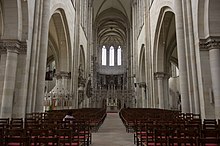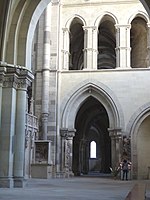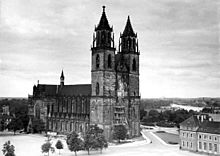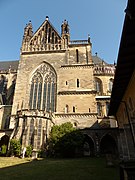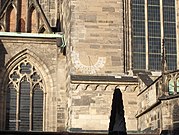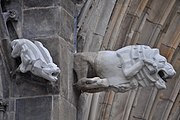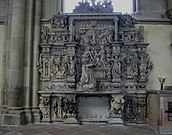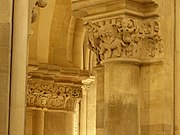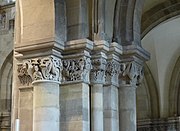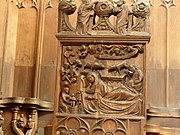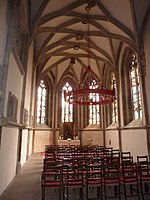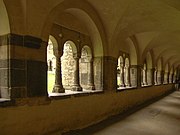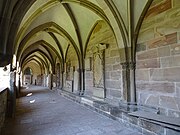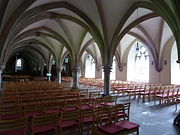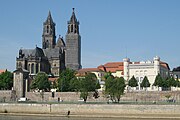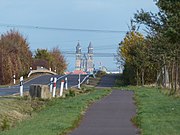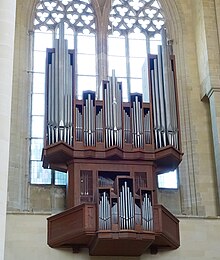Magdeburg Cathedral
The Magdeburg Cathedral (official name Dom zu Magdeburg St. Mauritius and Katharina ) is the sermon church of the regional bishop of the Evangelical Church in Central Germany , Evangelical parish church and at the same time the symbol of the city.
The cathedral is the first Gothic cathedral to be conceived from the beginning and the earliest completed Gothic cathedral on German soil. It was built as a cathedral for the Archdiocese of Magdeburg from 1207 or 1209 and was consecrated in 1363 . The cathedral is Otto the Great's grave church .
After severe damage from Allied air raids on Magdeburg in 1944/1945 and restoration after the war, the cathedral was reopened in 1955.
The cathedral is owned by the Saxony-Anhalt Cultural Foundation .
Building structure
The Magdeburg Cathedral is a three-aisled cruciform basilica with an ambulatory choir . Compared to most such structures, it has some special features:
- It has buttresses , but no buttresses , and no double-walled ceilings either .
- Aisles and ambulatory do not have or had no towing roofs, but free roofs across the upper aisle. This made a triforic bullet unnecessary .
- The choir has the cross-section of a gallery basilica , but there are no galleries above the side aisles of the nave .
- Although all of the high choir's shield arches are pointed, two of its girdle arches have no point.
- The longitudinal section of the nave shows a reversal of the bound system : the vault of the central nave has two yokes per supporting arcade arch. Every second pillar of the central nave vault stands over the top of an arcade arch.
The structure and archaeological findings indicate several changes to the plan that were made in the first years and decades of construction:
- The ambulatory should initially be narrower, and the actual polygonal chapels should have the shape of semicircular apses .
- Five bays of the ambulatory have groin vaults , although the supporting pillars show templates for vault ribs . These yokes have peg-shaped keystones, which is rare in groined vaults.
- The gallery above the ambulatory was not initially planned.
- The high choir is higher than initially planned, so that its pillars were reinforced during the construction period.
- Flank towers on the east side of both transept arms were only built up to the level of the eaves of the transept and high choir.
The middle section of the west building, which towers above the central nave, is more indebted to regional tradition than to French models.
Two round belt arches in the high choir , but all shield arches are pointed
history
Previous buildings
Otto I the Great founded the St. Mauritius Monastery in 937 , and in 946 his first wife Edith was buried there. Apparently Otto had already determined Magdeburg as his own burial place and in connection with this he established an archbishopric in Magdeburg as early as the 950s. Before the Battle of Lechfeld in 955, Otto vowed, even before his coronation as emperor on February 2, 962, to establish a diocese in Merseburg in the event of his victory - apparently this diocese should belong to the Magdeburg archbishopric, which was yet to be founded. In the 950s, there is evidence that he started a great new build. In order to underline his imperial claim in the succession of the Roman emperors, he had numerous treasures brought to Magdeburg, including the Codex Wittekindeus , an evangelist that was created in the Fulda monastery , and z. B. antique columns that were later placed in the choir of the late Romanesque-Gothic cathedral building. This first cathedral was probably a three-aisled, cruciform basilica with an east transept, east crypt and large atrium in the west. To the north, on today's Domplatz, there was a second, almost equally large and extremely richly furnished sacred building of unknown patronage , which formed a double church complex with the cathedral . 968 Magdeburg was the occasion of the Reichstag in Ravenna for the Archdiocese collected and Adalbert von Trier became the first Archbishop . The Moritzkirche was elevated to a cathedral.
On April 20, 1207 ( Good Friday ) a fire destroyed most of Magdeburg, including the cathedral, the north church and the imperial palace . Albrecht I von Käfernburg had the ruins of the cathedral torn down and in September 1207 laid the foundation stone for today's (third) cathedral, for which the stones and pillars of the old late Romanesque cathedral were reused.
Construction of the current cathedral
Archbishop Albrecht had studied in France and it is repeatedly assumed that the decision for a modern, Gothic choir floor plan goes back to him. Admittedly, this cannot be proven. Construction of the choir began in 1209, two years after the old cathedral burned down. The designs were Gothic from the start. There were apparently problems with the execution: while the chapels on the ambulatory have Gothic ribbed vaults, there are groin vaults on the ground floor of the ambulatory (which actually belong to the Romanesque period ) above pillars or wall templates, which obviously provided a ceiling made of ribbed vaults. The upper arcade of the choir, which in turn was higher than originally planned, is high-Gothic .
The changed building axis is very likely due to the fact that the cathedral was now aligned with the grave of Otto the Great. It was on the north side of the Ottonian cathedral, probably in the north transept, in the new Gothic building it is in the crossing between the rows of choir stalls. Editha, Otto I's first wife, was first buried in the church of Moritzkloster. The grave was then moved to the north transept of the Ottonian cathedral. The grave must have been moved into this after the start of the new Gothic building. According to the latest archaeological findings, the tomb erected in the apex of the ambulatory contains remains of her bones in a small lead box.
Already during the construction of the choir it was decided to build higher and wider. Changes to the plan are also detectable in the transept and in the east bays of the nave. In the second half of the 13th century, construction was interrupted for several years (document from 1274). The Magdeburg legend of the “Shepherd at Magdeburg Cathedral” can be traced back to this interruption and the subsequent resumption of construction work . According to her, a shepherd named Thomas Koppehele , who lived around 1240 and came from the Brandenburg Gräfendorf near Jüterbog , found a treasure of gold while tending sheep. He donated this to the then Archbishop of Magdeburg, who was able to significantly advance the construction of the Magdeburg Cathedral. Out of gratitude, the Archbishop had the stone image of the shepherd, his servant and their dogs placed above the so-called Paradise Gate, the northern entrance to the cathedral, where it can still be seen today.
The new building was then resumed and gradually moved further west. The vaults must have been withdrawn in the 1360s. Finally, the new building of the nave was consecrated in 1363 . The west facade and the towers were expanded in three sections, the basement was built before 1274, the second floor in the third quarter of the 14th century - probably around the same time as the corresponding sections of the nave - and the towers in the second half of the 15th century. or in the first quarter of the 16th century. The expansion of the space between the tower to the burial chapel took place under Archbishop Ernst II of Saxony . In 1520 the cathedral was finally completed.
In the cloister to the south of the cathedral are the remains of the Moritz monastery , founded in 937 and elevated to the status of the archbishopric of Magdeburg in 968 .
Reformation and Thirty Years War

At the time of the Reformation , Magdeburg was a stronghold of Protestantism , not least because Archbishop Albrecht von Brandenburg operated a lively indulgence trade , which caused public resentment. After his death in 1545, the cathedral was closed for 20 years. In 1567 the cathedral became Protestant, and the first Protestant service was celebrated there on the First Advent . The first Protestant cathedral preacher was Siegfried Saccus , assistant preacher Martin Gallus . In 1618 Heinrich Schütz , Samuel Scheidt and Michael Praetorius were involved in rebuilding the music in the cathedral.
During the Thirty Years' War on May 20, 1631, the troops of Emperor Ferdinand II under General Tilly and his troop leader Pappenheim conquered Magdeburg. Contemporaries across Europe were appalled by the subsequent massacre , in which around 20,000 people died and the city was not only plundered but almost completely destroyed by fire, the so-called " Magdeburg Wedding ". Between 2000 and 4000 people holed up for three days without food in the cathedral, which was spared from the fire, and is said to have owed their survival to the cathedral preacher Reinhard Bake , who kneeled in front of Tilly for the lives of the inmates, which was granted. Tilly had the cathedral cleaned and celebrated a Catholic service here on May 25th to celebrate his victory. The saying goes back to himself that the emperor had “married” the Magdeburg Virgin (from the city arms). The Archbishopric of Magdeburg came under the government of a Catholic archbishop again.
After the agreements of the Peace of Westphalia , the archbishopric was secularized in 1680 and the secular property became part of the margraviate of Brandenburg as the Duchy of Magdeburg . After 1806, when Magdeburg was handed over to Napoleon , tradition has it that the cathedral was used as a warehouse and also as a horse stable. It is said that the iron rings inserted into the walls of the cloister go back to this time. The occupation ended in 1814.
19th century
Friedrich Wilhelm III. von Prussia had the cathedral extensively restored between 1826 and 1834 under the direction of Karl Friedrich Schinkel . Among other things, the north transept, which was in danger of collapsing, and the equally unstable roof turret were repaired. The interior was newly plastered and whitewashed, which can still be seen today.
In the period from 1847 to 1906/07, the cathedral was equipped with artistically significant colored glass windows from six leading German glass painting workshops. They formed a unique colored ensemble with themes from the figurative as well as the ornamental area. All 89 window openings of the cathedral, with a total area of 2,300 square meters, were closed. Donors were the Prussian kings, Kaiser Wilhelm II, many other personalities and the city of Magdeburg. All window glazing was lost due to bomb detonations in the air raids on Magdeburg ; two particularly valuable and initially saved only during the GDR era.
The 20th century

At the beginning of the 20th century, a steam heating system with outlet openings in the floor and in the lowest sections of the central nave window was in operation for a short time. To do this, the windows were made smaller from below and artfully crafted grids were attached. During the Weimar Republic and National Socialism , Ernst Martin was cathedral preacher. He was close to politically national-conservative circles and in particular to the Stahlhelm and joined the DNVP . In autumn 1932 he held a service for the SA in the cathedral , at which SA flags were also greeted.
The cathedral was badly damaged in World War II . During the first bombing raid on the cathedral by the Allied bomber forces on September 12, 1944, a bomb hitting the south aisle damaged or destroyed epitaphs, all colored windows of the cathedral (except for two removed ones), as well as the entire wooden seating with the exception of the medieval choir stalls. During the heaviest air raid on Magdeburg carried out by the Royal Air Force on January 16, 1945 , several high-explosive bombs fell into the aisles. A total of approx. 300 m² of vaults were smashed. In addition, a single low- flying crew that appeared on February 17, 1945 in the middle of the day and without prior air alarm threw a fire bomb against the west side of the cathedral. The explosive device penetrated the façade of the intermediate tower building at the level of the third floor (see picture on the right) and caused the vaulted ceiling above the main organ to collapse. The fire that broke out could be extinguished so that the roof structure remained largely intact. Only the eastern parts with the choir , ambulatory and choir gallery have been completely preserved. Particularly valuable parts of the equipment had been saved by relocation or walling.
After restoration work, the cathedral was reopened on September 22, 1955 with the inauguration of Bishop Johannes Jänicke . Parts of the cathedral have been restored again since 1983. A solar system was installed in 1990. In 2005 the construction work on the north tower was completed, in 2006 the south tower and the roof of the Remter were restored. Since 2006, the early architectural history of Magdeburg Cathedral has been examined through archaeological excavations in order to gain knowledge about the previous buildings of the cathedral. During this investigation, the remains of Queen Edgitha , wife of Otto the Great, who died in 946, were discovered in a supposed mock grave .
During the fall of the GDR , the cathedral became the starting point for the peaceful revolution in Magdeburg. The calls for prudence by cathedral preacher Giselher Quast and cathedral preacher Waltraut Zachhuber made a significant contribution to this . In addition to its function as the bishop's church of the Evangelical Church Province of Saxony (EKKPS) with around 533,000 believers (until 2003), it is also the parish church for the Evangelical Cathedral Congregation, which has been in existence since 1869. Since the merger of the EKKPS with the Evangelical Lutheran Church in Thuringia , the cathedral has been the bishop's church of the newly formed Evangelical Church in Central Germany (EKM). After the end of the GDR, the cathedral became the property of the "Stiftung Dome und Schlösser in Sachsen-Anhalt", founded in 1996. The cathedral parish has the right to unrestricted use of the cathedral.
The 21st century
The structure is visited by more than 100,000 tourists annually. Since spring 2005, a tower has also been accessible again for tower ascents. In 2009, the 800th anniversary of the late Romanesque-Gothic cathedral was celebrated. For this purpose, the cathedral presented itself from December 2008 for a little over a year without any scaffolding.
architecture
The construction of the new Gothic cathedral took over 300 years from the start of construction in 1209 to the completion of the towers in 1520. The cathedral has a total internal length of 120 m and a ceiling height of 32 m. The south tower is 99.25 m high. The viewing platform of the north tower at a height of 81.5 m can be climbed as a viewing tower as part of guided tours over 433 steps .
The ground so close to the Elbe is soft except for a rock protruding into the river. Upon this rock, which accordingly Domfelsen is, the cathedral was built. Since the rock is too narrow for the entire cathedral, the south tower does not stand on the cathedral rock. This tower is therefore lighter, has no wide staircase, and the bells are housed in the north tower. The rock can only be seen when the Elbe has little water. Since little rain usually meant poor harvests, the cathedral rock was also popularly known as the hunger rock.
Exterior design
Tympanum with the Assumption of Mary above the portal of the north transept
Furnishing

|

|
|
|
Late Renaissance alabaster pulpit
by Christoph Kapup |
||
Although the cathedral has been looted and almost destroyed several times in the course of its history, it houses many preserved valuable furnishings and art treasures.
Alabaster pulpit
The pulpit of the Magdeburg Cathedral is one of the most important Renaissance works of art in Germany and was made by the Nordhausen sculptor Christoph Kapup in 1597 from the soft gypsum rock alabaster . On the pulpit are represented: St. John the Baptist, Christ as Savior, St. Mauritius, St. Catherine. He is supported by St. Paul as a pulpit basket carrier. On the pulpit stairs are depicted: God with Adam and Eve in Paradise, the Fall, the Flood. An extensive restoration was completed in 2009.
Sculptures of the wise and foolish virgins
The ten sculptures of the clever and foolish virgins of the Paradise Gate from 1240/50 were later placed on the walls of the north portal. It is the first monumental design of this theme, full of drastic directness compared to the much more restrained descriptions of the same theme in the time before, which were much smaller. Stylistically, they stand between the Bamberg princely figures and those of Naumburg. It is believed that the sculptor worked in the Bamberg school or was trained there. The figures are shown in the costume of the 13th century.
More art and cultural treasures
The following list of other art and cultural treasures is not complete, but shows a selection of the most important works.
- In the apse there are ancient porphyry , marble and granite columns that may have come from Ravenna . Otto I brought the columns with him from Italy as spolia for the construction of the first cathedral.
- According to tradition, Otto I also brought the baptismal font with him, supposedly originally a Roman fountain. The rock is Porfido rosso and is said to come from Hurghada in Egypt . It would therefore be a disagreement .
- The grave of Emperor Otto I is in the choir. When the grave was opened in 1844, a skeleton and clothing were found.
- An epitaph of the Canon Johann von Randow (1526–1572)
- The altar plate of the high altar in the choir, made of a stone of Bohemian marble, is the largest in Christendom, measuring 4.30 meters by 1.95 meters. The altar was consecrated in 1363.
- The St. Nicholas altar is a winged altar consecrated in 1506 in the Magdalen Chapel, which is displayed on the high altar on the name day.
- The sculptures of St. Katharina and St. Moritz are by the same artist and were created around 1250. The sculpture of St. Moritz is the oldest known European representation of a black African.
- The ruling couple from the 13th century in the hexagonal chapel, which was built around 1250, represents popular belief according to Otto I. and Editha .
- The choir stalls date from the middle of the 14th century. The relief fields show scenes from the life of Jesus. The carver's workshop probably also created the choir stalls for Bremen Cathedral . The structure and reliefs, especially of the lower cheeks, were considerably renewed in the 19th century.
- In Magdeburg Cathedral there are numerous historical grave monuments, epitaphs and tombstones from the 12th to 14th centuries, including those of Archbishop Friedrich von Wettin; at its foot end the well-known figure of the “ thorn extractor ”, identified by JW Goethe as a “barbaric imitation” of the figure of the same name on the Capitol in Rome.
- The Magdeburg Memorial was designed by Ernst Barlach in 1929 and is dedicated to the victims of the First World War. During the Nazi era, the mark was temporarily removed at the insistence of the then cathedral parish council and placed back in the cathedral in 1955.
- The tree of life crucifix in the chapel in the cloister dates from 1986 by Jürgen Weber . Jesus is hanging on a withered tree instead of a cross. In the places where its blood meets the tree, the tree sprouts again.
Part of the equipment saved during World War II
When the Allied air raids in the Second World War concentrated on the German inner cities ( Lübeck , Rostock ) from spring 1942 , efforts to protect the art of the cultural monuments located there were intensified. This also applied to the furnishing of churches, such as the Magdeburg Cathedral. Lighter air raids on Magdeburg had already begun in 1940, heavy attacks including the inner city followed from January 1944. Professor Hermann Giesau played a key role in the selection of particularly protected works of art as the provincial curator in the Prussian province of Saxony . In 1943, some of the movable works of art from Magdeburg Cathedral were relocated to Erxleben Castle : the choir stalls , the Nicholas altar and the two colored cathedral glass windows by Professor Fritz Geiges , created around 1900. Three valuable grave slabs were relocated to the Flechtingen Castle estate of Archbishops and the sandstone sculpture of Saint Mauritius . The tombs of Emperor Otto the Great and his wife Edgitha were given splinter protection in the cathedral by means of strong reinforced concrete slabs. The Kaiser Otto statue at the west portal was walled in for protection: a post-war photo from the Federal Archives shows how Otto is "freed" again. The choir stalls, the Nikolaus altar and the stained glass windows by Professor Geiges were evacuated in June 1945, shortly before the change from British to Soviet occupation, on the initiative of the Erxleben family from Alvensleben to Pattensen in Lower Saxony . These cultural treasures returned to Magdeburg from the Kunstgutlager Schloss Celle in 1954. The choir stalls were reinstalled in the cathedral after restoration in 1955. The two cathedral windows by Professor Geiges with the most important events in the history of the cathedral and the history of the Reformation in Magdeburg “in impressive glass painting” have not been reinstalled, “their whereabouts have not yet been clarified”. These two windows were the only cathedral windows that survived the air raids on Magdeburg intact.
Statue of Saint Mauritius , was relocated to the Flechtingen moated castle during the aerial warfare
Grave slab of Canon Johann v. Randow was at war after Flechtingen outsourced
Bronze epitaph of Georgius Koppehele († 1604), cathedral vicar and founder of the George Koppehele family foundation
Choir: Nativity to 1345. The choir was because of the air raids in the castle Erxleben outsourced
Cathedral retreat
The cathedral chapel has a trapezoidal floor plan, as three of its wings were aligned with the previous cathedral from the 10th century. The south wing is still designed in Romanesque style. The east wing contains a large two-aisled hall, also known as the remter . The Marienkapelle was added to it in the 15th century .
Cathedral in the city and landscape
With its soaring west building, the Magdeburg Cathedral is visible far beyond the city limits. With good visibility it can also be seen from the Brocken .
The Domplatz has seen several improvements since 1990.
Marienkapelle on the east wing of the cathedral chapel and Tatar tower
Cathedral and Fürstenwall from the right bank of the Elbe
Cathedral from Landesstraße 49 from Niederndodeleben
Organs
History of the organs
In 1363, the year the nave was consecrated, the Halberstadt organ builder Nikolaus Faber delivered the first organ whose bellows were operated by twelve calcans . Since the bellows was housed in the "tower chamber", it can be assumed that this organ was already on the west gallery. That is not certain, but a staircase built in the south tower up to the west gallery speaks for it. There is also evidence of a choir organ that was built in 1536 by the organ builder Michaelis for the cathedral in Halle and pledged to Magdeburg in 1541.
Between 1604 and 1615 Heinrich Compenius the Younger built a new organ; The instrument had 43 sounding stops on three manual works that could be played from two manuals. Its casing, designed with exorbitant effort, devoured around half the construction costs of the entire organ. The prospectus was extremely richly decorated and gilded. At the front of the organ were 30 rigid and twelve movable figures, u. a. a gilded rooster that could crow and flap its wings. This instrument was spared in the Thirty Years' War , when the troops of General Tilly devastated almost the entire city in 1631, but military personnel stole metal pipes a year later. A major renovation, for which Arp Schnitger submitted a cost estimate at the request of the cathedral organist Jacob Hasse in 1699, did not materialize. From 1769 to 1772, Christoph Treutmann d. Ä. a conversion. The choir organ, which had deteriorated over time, was put back in order in 1715 by Hasse's successor, George Tegtmeyers. There was also a positive that was structurally united with the choir organ, but tuned differently from it and therefore not playable together, which is said to have been built in 1619 “at Cassel by Georg Weißlanden, from Amberg”.
After Napoleon's troops had misappropriated the cathedral from 1806 to 1814, neither the rebuilt Compenius organ nor the church as a whole should have been in good condition. During the due restoration, which lasted from 1826 to 1834, the organ on the west gallery was rebuilt, this time by Theodor Hamann. The Rückpositiv fell victim to the increased space requirement for singers on the gallery. The Compenius prospectus was stored in the tower in 1830 and replaced by a new one from the master carpenter Schumann with a few 32 'pipes in the middle and Gothic elements.
Johann David Hamann, father of Theodor Hamann, built a new choir organ in 1807 that contained 15 stops on two manuals and a pedal. This had three 16 'registers and no mixtures (highest foot position 2'). It was removed when the renovation began in 1826.
When the composer and organist August Gottfried Ritter , who was also the “Royal Prussian Organ Auditor”, took over the cathedral organist position in 1847, organ music flourished there. On his initiative, the organ builder Adolf Reubke (Hausneindorf, Harz) built a new organ designed by Ritter between 1856 and 1861 with 81 stops on four manuals and a pedal. He used a number of stops from the previous organ. Schumann's prospectus was redesigned and painted in the neo-Gothic style. The organ was later expanded to include another manual, which was not based on its own fifth keyboard, but on the existing III. Manual could be played, extended to 88 registers. The instrument had slide chests and mechanical action with Barker levers. The size of the shops required the organ work to expand enormously and the arrangement of the console in the organ behind the 32 'pipe tower of the prospectus. The sound of the instrument is said to have been very good, on the other hand there were always problems with the action of the organ, which was extremely large for the time. The chronicler Rudolph Palme reported: "You sat at the organ like on a stubborn horse and were happy to get away without an accident."
While cathedral organist Ritter, according to tradition, enjoyed playing the Reubke organ, his successor, Theophil Forchhammer , who was in office from 1886, had completely different expectations of the cathedral organ. In 1906 he therefore commissioned the organ builder Ernst Röver , who had taken over Reubke's workshop in Hausneindorf, for a completely new main organ. This had 100 stops on three manuals and a pedal. The prospectus was moved 2.50 m to the rear and the console was arranged at the front in order to gain space for a choir in front of the organ and to allow visual contact between the conductor and the organist - which is missing with Reubke's organ. The pneumatic action, usually notorious because of its inherent inertia, functioned relatively precisely in Röver's organ, also thanks to the “box drawer” modified by Röver. The powerful sound of the full work filled the cathedral to the last corner, but according to the Reich organ auditor Georg Kempff, the organ was good for "nothing other than roaring and whispering" and the like. a. which is why, as early as 1938, he demanded that it be demolished and a new building built in line with contemporary tastes. Debates about how to handle the organ became obsolete in 1945 when the vault above it collapsed as a result of a low-flying attack and only the front, protected by the large pointed arch from the falling, heavy rubble, remained intact. The stored Compenius prospectus was taken out of the tower in 1945 and burned. The "Golden Rooster" was retained.
Due to the destruction of the cathedral, the remter was used for church services after the war. The Magdeburg organ builder, Brandt, hid the usable remains of the totally destroyed main organ. A romantic instrument from the organ building company Furtwängler & Hammer , probably from the auditorium of the war-damaged cathedral high school, served as the remter organ ; it had 18 stops on two manuals. In 1949 the instrument was returned to the Domgymnasium. This was temporarily followed by a five-record positive with an attached pedal in the remter, until a new organ from the Potsdam organ building company Schuke with 28 sounding stops on three manual works and a pedal was completed in the same year. The positive that was no longer needed was then placed in the community hall of the Protestant old town of Magdeburg, where it is still in service today. Since the cathedral - apart from a short period at the beginning of the 20th century - has always not been heated, the cathedral parish uses the remter, which is equipped with a heater, for six to seven months of each year as well as for prayer and other small events . This is one of the reasons why they needed a good organ there.
Karl Schuke planned the construction of this organ. The post-war construction was difficult: Schuke obtained most of the organ metal required for this from the scrap pipes of the Röver organ. In September 1947, a scrap metal transport to Potsdam failed only because boxes were missing. The demanding production of reed pipes was hardly possible in the Soviet occupation zone or in the newly founded GDR, so that temporarily used pipes and pipe parts were used. While Schuke wanted to build an organ with 22 registers roughly in the middle of the remter, the cathedral organist at the time, Gerhard Bremsteller, set it up behind a column on the northern end of the long, low, two-aisled remter. This space was not only spatially cramped, but also acoustically disadvantageous. Cold air, which escaped from a crypt opening there, also put part of the organ out of tune. Schuke's sound concept at the time (unusually high cuts on the relatively narrow labia of the principals and mixtures, which produced a soft, flute-like sound) also met with rejection from supporters of a contemporary taste that was characterized by a return to baroque organ building traditions. This sound was also felt to be unsuitable for the Gothic architecture of the Remter. Inaugurated on December 3, 1949, the new Schuke organ was temporarily the only larger mechanical slider-drawer organ in Magdeburg, and was therefore used and worn a lot.
Towards the end of the 1950s, the cathedral parish received a two-manual organ with 27 registers and an electro-pneumatic action, originally made in 1957 by Orgelbau A. Schuster & Sohn (then Zittau) for the Magdeburg Heilig-Geist-Kirche . This could no longer be erected at its destination because this church, which had already been rebuilt, but which the socialist planners did not fit into the cityscape, was blown up in 1959. Since there was no organ in the cathedral since the bombing of 1945, the Schuster organ (which was completely undersized for the cathedral) was installed there.
Extensive repairs were required on the Schuke organ in Remter as early as 1964. At that time the keys of the first manual were already tapped up to 4 mm deep. The post-war material was only able to withstand such stress to a limited extent. A number of other repairs followed, as well as lengthy and often controversial negotiations between the cathedral parish, monument preservers, organists, organ builders and appraisers about the sound, condition, preservation value and other things. In 1988 the organ was placed under a preservation order and labeled as a "cultural property of the socialist society". The chronic technical defects and sound problems could only be remedied by serious and expensive interventions in the original substance, which, however, have now been prohibited by the preservation authorities. Preserving the organ in terms of monument protection would have required, for example, the retention of inferior post-war materials, as well as pipes with a poor sound quality. After a fifth cleaning and - as far as possible - repair carried out in 1992, a new panel heating system caused further damage to the organ, which made it unplayable. So it was shut down in 1996/1997. In July 2007, they were dismantled before the remter was renovated, which caused a lot of dirt, and was initially moved to the Valley Organ Center . In 2008 the organ building company Jakubowscy installed the organ in Trzebinia-Siersza (Poland).
After the cathedral came into state ownership in the course of the Prussian secularization in 1830 , there was a lack of interest and money for the construction of a main organ with an appropriate sound volume on the west gallery, which would be used by the Protestant community. A sum made available annually by the state over a period of time was always too small to be able to realize the project in one go. The preservation authorities also refused to put up a large organ, although the cathedral has an organ tradition spanning many centuries. For the cathedral community it was also snubber that the monastery church, which is located near the cathedral and used as a municipal concert hall, which is much smaller than the cathedral, was equipped in 1979 with a new concert organ with at least 63 registers, four manuals and almost 5400 pipes. Around 1960 there were plans for an organ in the transept that could be financed solely by the cathedral community and that was to represent a compromise solution for the acoustics in the transept and main nave. These became reality - after almost ten years of waiting - with the construction of the transept organ by the Alexander Schuke company (Potsdam) in 1969/70. The Schuster organ from 1957 was installed in 1975 with a somewhat reduced pipework and without a prospectus in the relatively small Sankt-Nicolai-Kirche in Magdeburg-Neue Neustadt. It is now worn out there (2019) and is to be replaced by a new building in which the useful register of the Schuster organ will be integrated.
Today's instruments
Today there are four organs in the cathedral: the above-mentioned transept organ, the chest organ, the main organ from the company Alexander Schuke (Potsdam or Werder / Havel) from 2008 on the west gallery, and the organ from the company Glatter-Götz from 2011 in the remter.
Transept organ
The instrument is on the ledge of a hallway above the Paradise Gate. The Halle architect Fritz Leweke designed the case, which at the time was made very roughly from softwood and is to be replaced by a hardwood case in a more elegant design. Prospectus pipes made of cheap material that are deformed by their weight should also be replaced. The neo-baroque organ, with its 37 registers on three manuals and pedal, can at best fill the transept with sound and is only vaguely audible in the other areas of the cathedral. In addition, nobody is in the transept during normal church services, as the liturgical altar and the standard seating in the main nave are to the west of the crossing. Dust raised by archaeological excavations in the cathedral put a strain on the transept organ. After the new main organ was completed, the attempts made in 1994 to give the transept organ a significantly more powerful sound by changing the intonation were revised during a repair carried out in 2010, and the dirt was also removed.
|
|
|
|
|||||||||||||||||||||||||||||||||||||||||||||||||||||||||||||||||||||||||||||||||||||||||||||||||||||||||||||||||||||||||||||||
- Coupling : I / II, III / II, I / P, II / P
- Remarks
- ↑ Originally two or three times with a seventh as the third choir.
- ↑ Originally Gedackt 8 ′ and Gemshorn 4 ′.
Chest organ
When it was possible to equip the cathedral with appropriate organs after the dissolution of the GDR, it was the first purchase and comes from the English organ builder Peter Collins. Their disposition is: Gedackt 8 ′, Rohrflöte 4 ′, Principal 4 ′, Sesquialtera II (from c ′). It is portable and is z. B. used as an accompanying instrument for oratorio performances.
Main organ
The estimated cost of the new main organ on the west gallery was 3.8 million DM. The EU took over 1.8 million DM as part of a regional development fund. In addition, several large donations and support from companies and the city of Magdeburg were received. The association “Aktion neue Domorgeln Magdeburg eV” founded for the construction of a new main organ and a Remter organ. V. ”, who chose the Golden Rooster from the Compenius prospectus as his symbol, placed the order in 2003 with the Alexander Schuke Potsdam Orgelbau company , which relocated its headquarters from Potsdam to Werder / Havel in early 2004. To illustrate the appearance of the new organ, before construction began, a 1: 1 scale image of the future prospectus hung on a giant canvas above the west gallery. The Schuke company started building the largest organ in Saxony-Anhalt in spring 2006. It was inaugurated on May 18, 2008.
The instrument is 14.75 m high, 10.75 m wide, 9.15 m deep, weighs 37 tons and contains 93 registers (92 real registers and one transmission). The 6139 pipes, of which 5124 are made of metal and 1015 are made of wood, can be played using four manuals and a pedal. The largest pipe is the 10.37 m high wooden pipe of the "C" of the Principal 32 ′, the "F sharp" of the same register is the largest prospect pipe.
The organ consists of five works: Hauptwerk, Positiv, Schwellwerk, Solo and Pedal. The main work is located above the console and is represented by some prospect pipes from the Principal 16 'register. The solo work, of whose double principal 8 ′ there are a few pipes in the prospectus, is placed above the main work. The swell works behind the main work, the positive one above the swell work and behind the solo work. A few solo tongue registers are attached to the roof of the case and radiate almost horizontally into the room just below the central nave vault. The pedal registers, divided on the C and C sharp sides, flank the four manual works on both sides and extend almost over the entire depth and height of the organ.
The action is basically mechanical, but due to the size of the organ it contains various additional devices (for example additional electrical chargers for bass pipes that require a lot of wind and some high pressure registers) to maintain a certain ease of movement. For this purpose, used for the first time by a European organ builder, “Kowalyshyn machines”, a development by the Fisk company , are built into this organ. The main instrument of the cathedral embodies the conception of a classical symphonic organ with a musical focus on German and French organ music. This type of organ is able to sonically dominate such an elongated, large room as the Magdeburg Cathedral. The manual range up to c '' '' underscores the concept of the organ as a concert instrument.
A replica of the golden rooster is hidden in the housing above the gaming table and can be extended by pressing a switch.
The organ contains a plenum based on central German organ building traditions, which merges into a symphonic breadth and abundance and is supplemented in all works by French timbres . German romantic and French organ music can be represented very well on it. The organ has the following disposition:
|
|
|
|
|
||||||||||||||||||||||||||||||||||||||||||||||||||||||||||||||||||||||||||||||||||||||||||||||||||||||||||||||||||||||||||||||||||||||||||||||||||||||||||||||||||||||||||||||||||||||||||||||||||||||||||||||||||||||||||||||||||||||||||||||||||||||||||||||||||||||||||||||||||||||||||||||||||||||||||||
- Coupling : IV / I; III / I; III / I sub; II / I; III / II; III / II sub; III / III super; I / P; II / P; III / P; IV / P.
- Playing aids : swell kicks for positive and swell; 10,000 typesetting combinations.
- Remarks
- ↑ Penetrating tongues.
- ↑ Opening tongues.
- ↑ CF wood.
Remter organ
On October 8, 2011, the organ for the newly designed remter of the cathedral was consecrated. The instrument was built by Orgelbau Glatter-Götz in cooperation with the organ building company Rosales (Los Angeles) and has 22 registers, two of which are partially transmissions, on two manuals and a pedal. The money for this new building came from an injection of funds from the state “Economic Stimulus Program II” and, similar to the main organ, also from numerous larger and smaller donations. The disadvantages of the location of the Schuke organ, which was removed from the Remter in 2007, were circumvented by placing the Glatter Götz organ under an arch in the passage from the Remter to the side chapel. With two blinds - with the exception of the pipes of the violin principal 8 ', which are on the chapel side of the organ in the prospectus - the sound of the rear threshold can be directed either into the side chapel, into the remter or into both rooms, so that the rear threshold works with the appropriate blind position also acts as a chapel organ. As with the previous instrument, the playing and stop actions are mechanical and the pipes stand on slider chests.
|
|
|
||||||||||||||||||||||||||||||||||||||||||||||||||||||||||||||||||||||||||||
- Coupling : II / I, I / P, II / P
Bells
The church bells of the cathedral hang on the third, fourth and fifth floors of the north tower. Of the ten to fifteen bells of the cathedral, some of which were medieval, five are still preserved, of which the three larger form one of the heaviest and largest baroque bells in Germany. Today's Susanne , also known as Maxima , weighs almost nine tons and is already the fourth successor. The Apostolica is famous for its beautiful sound. Both bells hang on the 4th floor in the baroque belfry, which was built using wood from an even older construction. In 1993 the riveted steel yokes were replaced by those made of oak. Later, the bells stopped for five years due to damage before the two biggest bells rang again at Christmas 2004.
Dominica, which was previously hanging on the third floor , had to be repaired again since around 2007 and has been silent ever since. Since the bell chamber there only has a sound exit window (facing north), its sound radiation was restricted. It was repaired in the Lachenmeyer bell workshop in summer 2019 . It is now expected to be available for viewing in the nave for two to three years. If the bell is extended, it should then be hung in a new bell cage to be built in the belfry with three windows on the 4th floor above the Susanne and the Apostolica.
Below the bell chamber is the discarded medieval wooden clapper of Susanne , which was hung in the bell on special occasions (e.g. during Lent or during mourning) to muffle its sound appropriately for the occasion.
| No. |
Name (position) |
Casting year | Foundry, casting location |
Diameter (mm) |
Mass (kg) |
Percussive ( HT - 1 / 16 ) |
tower |
| 1 | Susanne | 1702 | Johannes Jacobi , Berlin | 2,464 / 2,470 | 8,800 | e 0 +6 | North tower, 4th floor |
| 2 | Apostolica (also serves as an hour-bell) | 1690 | Jacob Wenzel, Magdeburg | 1,938 / 1,945 | 4,980 | b 0 +5 | |
| 3 | Dominica | 1575 | Eckart Kucher, Erfurt | 1,620 | 2,362 | h 0 +8 | until June 5, 2019 in the north tower, 3rd floor; currently on display in the nave |
| 4th | Orate | 13th century | unknown | 665 | ≈200 | e 2 +1 | Roof rider (since 1994) |
| - | Bell ( clock strike ) | 1396 | unknown | 1,359 | ≈1,500 | f 1 −1 | North tower, 5th floor (in the octagon) rigidly suspended |
Plans are currently underway to supplement the ringing on 12 bells. Additional bells with the striking tones d 0 , g 0 , d 1 , e 1 , f sharp 1 , g 1 , a 1 and b 1 are planned . Some of the new bells, including a 14-tonne drone bell with a striking note d 0 , which is unique in Germany , will then hang in the previously empty south tower. The bells would then weigh a total of 42 tons.
See also
literature
In alphabetic order
- Campaign New Cathedral Organs Magdeburg e. V. Martin H. & Ulrike Groß: Organs in Magdeburg Cathedral, then and now . 2008, ISBN 978-3-935971-44-7 .
- Hildegard Bernick: The rescue of the choir stalls from the Magdeburg Cathedral 1943 to 1954 . Ed .: Förderkreis Schlosskirche Erxleben eV, Magdeburg and Erxleben 2009, 2016
- Heiko Brandl, Christian Forster: The Cathedral of Magdeburg. Volume 1: Architecture. State Office for Monument Preservation and Archeology Saxony-Anhalt. Schnell & Steiner publishing house, Regensburg 2011, ISBN 978-3-7954-2462-6 .
- Heiko Brandl, Christian Forster: The Cathedral of Magdeburg. Volume 2: Equipment. State Office for Monument Preservation and Archeology Saxony-Anhalt. Schnell & Steiner publishing house, Regensburg 2011, ISBN 978-3-7954-2462-6 .
- Marco Chiriaco: The Cathedral of Magdeburg - The building history of the Gothic cathedral based on the building . Munich 2006, ISBN 3-638-67483-5 .
- Erhard Drachenberg , Michael Sußmann (authors), Dietrich Otte (illustrations): The lost stained glass of Magdeburg Cathedral. A documentation. Edition Leipzig, Leipzig 2014, ISBN 978-3-361-00696-6 .
- Friends of Magdeburg Cathedral (Ed.): The Magdeburg Cathedral. Edition Akanthus, Spröda 2005, ISBN 3-00-015279-2 .
- Christian Forster, Birge Tetzner: The Magdeburg Cathedral. Grave of Otto the Great. Kunst + Reise, Bad Homburg 2009, ISBN 978-3-940825-17-9 .
- Christian Forster: Magdeburg and Walkenried - To the early Gothic composite capitals in Magdeburg Cathedral. In: INSITU. Journal of Architectural History . Volume 1, No. 2, 2009, pp. 81-90.
- Johann Friedrich Wilhelm Koch : The cathedral to Magdeburg. 1815 ( limited preview in Google Book search).
- Hans Michael: The choir stalls in Magdeburg Cathedral. Leben-Jesu-Tafeln and Misericordien around 1360 and 1844. Norderstedt 2002, ISBN 3-8311-3899-0 .
- Hans-Joachim Mrusek : Three German domes: Quedlinburg, Magdeburg, Halberstadt. Verlag der Kunst, Dresden 1963, DNB 830849068 . (2nd, revised edition. 1983, DNB 840330693 and Hirmer, Munich 1983, ISBN 3-7774-3510-4 ).
- Gisbert Porstmann: The choir stalls of the Magdeburg Cathedral. Iconography style history interpretation. Berlin 1997, ISBN 3-931836-13-4 .
- Giselher Quast, Reinhard Winkler, Hans-Jürgen Jerratsch: The Cathedral of Magdeburg. (= DKV art guide. No. 415). 11th edition. Munich / Berlin 2008, ISBN 978-3-422-02159-4 (also published in English).
- Giselher Quast, Hans-Jürgen Jerratsch, Constantin Beyer: The Magdeburg Cathedral (= Great DKV Art Guide ). Munich / Berlin 2004, ISBN 3-422-06389-7 .
- Birte Rogacki-Thiemann: The Magdeburg Cathedral St. Mauritius et St. Katharina - Contributions to its building history from 1207 to 1567 . Petersberg 2007, ISBN 978-3-86568-263-5 .
- Volker Seifert: Research report on the building history of the late Romanesque Magdeburg Cathedral. In: Art Chronicle . 63, 2010, pp. 597-609.
- Michael Sussmann: The Cathedral of Magdeburg. Art publisher Peda Gregor, 2002, ISBN 3-89643-056-4 .
- Ernst Ullmann: The Magdeburg Cathedral: Ottonian foundation and Staufer new building. Leipzig 1989.
Web links
- Evangelical cathedral parish of Magdeburg
- Archaeological excavations in Magdeburg Cathedral
- The Magdeburg Cathedral in 560 pictures
- Magdeburg Cathedral pictures
Individual evidence
- ^ Magdeburg, Landesarchiv Sachsen-Anhalt, Rep. U 1, Tit. I, No. 2 ( MGH DD OI , No. 14, pp. 101-102).
- ^ CL Brandt: The Cathedral of Magdeburg. Magdeburg 1863, p. 9 ( limited preview in the Google book search).
- ↑ Birte Rogacki-Thiemann: The Magdeburg Cathedral of St. Mauritius and St. Katharina - Contributions to its building history from 1207 to 1567. Michael Imhof Verlag, 2007, ISBN 978-3-86568-263-5 , pp. 66–74, construction phase 2
- ↑ Remains of Queen Editha identified. In: Spiegel Online. June 16, 2010. ( spiegel.de ( Memento from May 25, 2012 in the web archive archive.today ))
- ↑ a b The Cathedral of Magdeburg St. Mauritius and Katharinen: construction began 800 years ago. at kukma.net, accessed on June 15, 2010.
- ↑ dombaumeisterev.de
- ↑ Erhard Drachenberg: The lost stained glass of the cathedral in Magdeburg . 2014
- ↑ a b c Excerpt from the 2008/09 yearbook of the Dome und Schlösser Sachsen-Anhalt Foundation, ISBN 978-3-00-031297-7 in: "15 Years of the Förderverein Dom zu Magdeburg eV - A Review", publisher: Friends of Magdeburg Cathedral V., Am Dom 1, 39104 Magdeburg. See also: http://www.ek-md.de/domgemeinde/fileadmin/user_upload/Bilder_Dokumente/Dom/Domfoerderferein/Domfoerderverein_15_Jahre.pdf
- ↑ Maik Hattenhorst: Magdeburg 1933. A red city turns brown. Mitteldeutscher Verlag, Halle (Saale) 2010, ISBN 978-3-89812-775-2 , pp. 120–121.
- ↑ a b Organs of the Past , domorgel-magdeburg.de as well as an eyewitness report in Bayerischer Rundfunk, program “Bayern 4 Klassik”, 2008.
- ↑ Hildegard Bernick: The rescue of the choir stalls from the Magdeburg Cathedral 1943 to 1954 . Erxleben, Magdeburg 2009, 2016
- ↑ Johannes Jänicke: I was able to be there. Wichern-Verlag, 1984.
- ↑ Cathedral tours. on the website of the Evangelical Cathedral Parish .
- ↑ Helmut Asmus: The Imperial Grave Church - Otto the Great and the Cathedral of Magdeburg . Sricptumverlag, Halberstadt 2009, p. 61 .
- ↑ Hildegard Bernick: The rescue of the choir stalls from the Magdeburg Cathedral 1943 to 1954 . Ed .: Förderkreis Schlosskirche Erxleben eV Magdeburg and Erxleben. 2009, 2016
- ↑ Hildegard Bernick: The rescue of the choir stalls from the Magdeburg Cathedral 1943 to 1954 . Magdeburg and Erxleben 2009, 2016. p. 17
- ↑ Mystery of the Gothic Organ , magdeburgerdommusik.de
- ↑ a b c magdeburgerdommusik.de
- ↑ domorgel-magdeburg.de: Compeniusorgel 1786
- ↑ magdeburgerdommusik.de
- ↑ a b More information on the history of the organs on the Dommusik website; and http://www.domorgel-magdeburg.de/remterorgel.pdf
- ↑ orgelbau-welde.de: Catalog of works
- ↑ organ - Organmastery - Jakubowski Krzysztof - Build instrument. Retrieved October 14, 2019 .
- ↑ Information on the organ ( page no longer available , search in web archives )
- ↑ Information on today's organs on the Dommusik website.
- ↑ Christina Bendigs, Volksstimme Magdeburg: Crowdfunding for Magdeburg's Paradiesorgel. Retrieved July 11, 2019 .
- ↑ Information on the transept organ
- ↑ To the disposition of the transept organ.
- ↑ schuke.de
- ↑ schuke.de: St. Mauritius and Katharina
- ↑ a b Magdeburg Cathedral - the main organ - music case Saxony-Anhalt. Retrieved on October 14, 2019 (German).
- ↑ domorgel-magdeburg.de
- ↑ Information on the Remter organ
- ↑ Karl Walter: Bell customer. Pustet, Regensburg a. a. 1913, p. 778.
- ↑ Recording of the Apostolica (12:23 min) on YouTube .
- ↑ Brandl / Forster, p. 867.
- ↑ Claus Peter: The bells of the cathedral in Magdeburg. In: Rüdiger Pfeiffer-Rupp, Jörg Poettgen, Jan Hendrik Stens (eds.): Mensio - descriptio - structurarum analysis - interpretatio. (= Writings from the German Bell Museum. Volume 13). A commemorative publication for Konrad Bund on the completion of the 70th year of life. Gescher 2015, DNB 1079622071 , pp. 79-104.
- ^ Rainer Schweingel: Bells for the landmark of Magdeburg. Retrieved November 5, 2017 .
- ^ Ivar Lüthe, Volksstimme Magdeburg: Magdeburg Dominica drops the covers. Retrieved October 8, 2019 .
- ↑ a b Cathedral bells Magdeburg e. V .: Overall project .
- ^ Martin Rieß, Volksstimme Magdeburg: First Magdeburg cathedral bell is being repaired. Retrieved May 16, 2019 .
- ↑ Constanze Treuber and others: Cast diversity. Bells in Saxony-Anhalt. Hinstorff, Rostock 2007, pp. 97-104.
- ↑ https://www.magdeburgerdom.de/content/domgemeinde/gemeindebriefe/2019/GB_19_11_12_web.pdf , p. 15.
- ↑ Martin Rieß, Volksstimme Magdeburg: Magdeburg cathedral bell is being restored. Retrieved October 8, 2019 .
- ↑ Magdeburg Cathedral - Glocke 4 "Orate" on YouTube .
- ↑ domglocken-magdeburg.de
- ↑ A cathedral bell for Magdeburg Cathedral , www.wamsiedler.de, July 31, 2017, accessed on July 31, 2017.
- ↑ Ambitious project - new bells for Magdeburg Cathedral , church on radio SAW, August 1, 2017, accessed on August 13, 2017.
- ^ Peter Ließmann, Volksstimme Magdeburg: Unique bell for the Magdeburg Cathedral. Retrieved May 16, 2019 .
Coordinates: 52 ° 7 ′ 28.9 ″ N , 11 ° 38 ′ 4.2 ″ E


